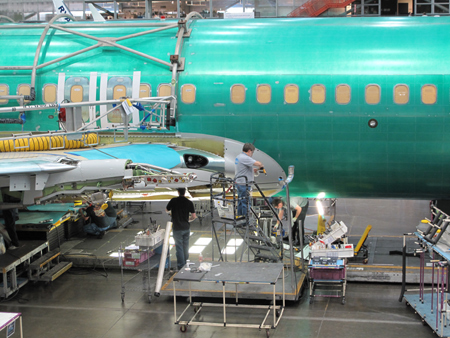Photos
Boeing's reach is woven into China's aviation industry
Updated: 2011-01-14 13:35
By Li Xing (China Daily)
|
 |
|
Employees work on the wings of a Boeing 737 in Kansas. [Photo / China Daily] |
SEATTLE, Washington - David Langridge believes his job is taking him "around the world" without getting on board an airplane.
A driver with Boeing Commercial Airplanes, Langridge takes guests of the world's largest commercial aircraft manufacturer between their hotels and Boeing's sites in the suburban cities of Everett or Renton. There, the guests - pilots, mechanics, engineers and airline managers - work with Boeing staff to get their new aircraft inspected, receive training, improve their skills in aircraft maintenance or develop expertise in airport management.
Of his guests from around the world, many are Chinese.
"I feel like going around the world (with these guests)," Langridge said.
China is a frequent destination for Boeing's top commercial executives. Nicole Piasecki, Boeing commercial airplanes' vice president of business development and strategic integration, made her first visit to China in 1985 in an exchange program.
She remembered flying to Xi'an in an old Russian plane. The seats were not bolted down firm. "When we were taking off, our whole row went back," she recalled.
James F. Albaugh, executive vice president of the Boeing Company, has visited China three times since he also became president & CEO of Boeing Commercial Airplanes in September 2009.
"I'd like to think we (Boeing and China) are partners," Albaugh said in a recent exclusive interview with China Daily. "We worked with China to develop its aviation industry, aviation infrastructure, and we continue to depend on them as they, I hope, depend on us."
Boeing's relationship with China covers almost all major aviation sectors, according to Boeing commercial airplanes executives.
There is the confidence in the growth of China market for Boeing's airplanes, despite competition from Airbus in Europe and China's effort to expand its high-speed railways and build its own regional and large aircraft.
"The prospects of China is very good," Albaugh said.
During his first visit to China, he was told that China needed to buy 200 airplanes a year. But Albaugh disagrees. "In my view, there is going to be a lot more than that, close to 300," he said.
Albaugh said he not only summed up the number of airports China was going to build, but also added "the size of the population, the percentage of the population that is likely to fly but hasn't flown yet, the percentage of the population that now wants to fly for leisure, travel, the number of tourists and business people that are coming to China from other countries".
In a word, "I think the opportunities are huge," Albaugh said.
Randy Tinseth, vice president of Marketing of Boeing Commercial Airplanes, had more numbers to show how China is "the market moving forward".
He told China Daily he based his analysis not only on China's present development but also on a 20-year forecast that his research team comes up every year since the 1950s, which "allows us to take a fresh look at the market and incorporate the latest thinking and analysis of the market".
Having gone through the economic cycles and business challenges over nearly six decades, Tinseth said air travel still managed to grow about 5 percent a year not only due to the strong link between air travel and the economy but also due to people's curiosities and their need to travel.
Since he visited China for the first time in the early 1990s, Tinseth has made more than 30 trips there, seeing the dramatic changes in skylines in Shanghai and experiencing "more complicated" driving on the road in Beijing.
"Putting yourself in a corner of Shanghai, you can feel the energy, with a certain smell. There is also a certain sound, like New York in similar ways, its business acumen, the banking, for instance," he said.
Today, Boeing has 31 customers in China flying about 870 Boeing airplanes. Moreover, Tinseth reckoned that about 190 million Chinese fly in Boeing airplanes. Two months ago, he announced in Beijing that his company forecasted that China would need 4,330 new commercial airplanes valued at $480 billion over the next 20 years.
In short, 20 years from now, more than 40 percent of all travel will begin and end within the Asia-Pacific market," Tinseth said, and China is about 40 percent of that demand. "This is our idea of the important role that Asia as well as China will play," he said.
By 2030, China's passenger traffic would reach 1.5 billion, Tinseth said, quoting from Boeing's 20-year forecast released recently.
"We cannot underestimate the power of tourism, both domestic and outside China. I know in the (drafted) 12th Five-Year Plan, tourism will be raised in terms of importance," he said.
Tinseth said he and his team are aware of China's ambitious plan to develop a high-speed rail system. Boeing sees it as both competition and complementing.
His research team examined the high-speed rail development plan. They concluded that high-speed rail would attract a lot more passenger flow between two cities within 800 km.
Travelers are likely to debate between whether to ride or to fly when cities are 800 to 1,200 km apart.
But they believe that most passengers would favor air travel if the distance goes beyond 1,200 km, as personal wealth grows and time becomes more important, Tinseth said.
"There are challenges in all types of transportation," he said, citing that some high speed rail terminals are located outside downtown areas. "Airlines have to work with railroads together."
But Boeing's footprints in China go far beyond selling airplanes.
"There is not a plane we built that doesn't have parts from China in it," Albaugh said.
According to Boeing, its procurement from China is "significantly greater than other aviation companies. Boeing is China's aviation manufacturing industry's largest foreign customer."
"When you look at all our joint ventures in China, we employ about 6,000 people in total," Tinseth said. Ray Conner, Boeing Commercial Airplanes' vice president and general manager of its supply chain management and operations, made his first trip to China in 1988. He was part of the Boeing team to move the production of vertical fins to Xi'an.
Conner showed a map of China marked with dots of field service, technical support, training and flight simulators across the country. Its field service reaches as far west as Ali, Tibet autonomous region; Harbin, Heilongjiang province in the northeast; and Haikou in the south. It also covers some second- or third-tier cities such as Dunhuang in Gansu, Jiuzhaigou in Sichuan, and Linzhi (Nyingchi) in Tibet.
Apart from vertical fins manufactured in Xi'an, horizontal stabilizers are made in Shanghai and a joint-venture in Tianjin produces interior component parts and nonmetallic composite work for airplanes, Conner said.
Chinese manufacturers in Shanghai, Xi'an, Tianjin as well as in Chengdu and Shenyang also contribute parts to Boeing's "next-generation" 737s, or 787 "dreamliner", or 747-8s.
"I've watched our relationship grow" and China is "participating in every one of our airplanes today," Conner said.
Emphasizing that Boeing has been a "solid, quiet and dependable" partner, Conner said his company has been "part of the fabric of the whole aviation industry in China."
Since 1993, Boeing has helped train more than 37,000 Chinese pilots, mechanics, engineers and other professionals in flight operations, maintenance, air traffic management, manufacturing, quality assurance, finance and industrial engineering, according to Boeing.
A model of a Cathay Pacific freighter stands by the door inside the office of Lou Mancini, senior vice president in charge of its commercial aviation services. An airplane piece is kept in a glass frame on a shelf on the other side of the door.
The piece was cut from a 747-400 Cathay Pacific airplane to create a cargo door when it was converted into a freighter in 2005.
It was the first conversion job done by Taeco-Taikoo (Xiamen) Aircraft Engineering Co Ltd, a joint venture in Xiamen in airplane repair, maintenance, part manufacturing, component service and conversion, with Boeing holding 9.1 percent of the shares.
The piece was cut out on April 28, 2005, and since then, Taeco has finished between 35 to 40 new 747-400 Boeing converted freighters, Mancini said.
A computer monitor in Mancini's office, which is linked to its operations center, maintains almost real-time watch over the 1,500 Boeing airplanes while they are flying. It is a "fancy prognostic forecasting system, so you can monitor your airplane and figure out what maintenance it is going to need in a next couple or three days," Mancini said.
Around the world, 40 customers, including Air China, use the systems, so that they would be serviced 24 hours, seven days a week.
"You know exactly the status of an airplane in 20 seconds," Mancini said. "I can log on at home with my iPad and watch airplanes flying."
In terms of pilot training, Boeing is moving a 787 flight simulator to Shanghai, to join five 767 simulators there, Mancini said.
Boeing is also involved in cruise scheduling in China. Before the Beijing Olympics, it worked with Beijing Capital International Airport to optimize the airspace around the airport to increase capacity.
Mancini highlighted Boeing service teams now spread across China. With the required navigation performance technology, Boeing has worked with the Chinese airlines to fly into Nyingchi, Tibet, in between the mountains on the roof of the world.
"We are very interested in air traffic management, and we would like to help China out," he said.
As Chinese airlines fly more Boeing aircrafts, its services will also grow in China.
"We are global but local," Mancini said. "I cannot imagine supporting the world without being local."
Despite a Mandarin table at the operations center, Mancini said Boeing will build a satellite facility in Beijing and have it up and running around June. It will also be connected with the computer systems at main operation center and all the telecommunication systems in the US.
"It will be connected to the operation center but it will allow us to better understand China's market and its growing needs," Mancini said.
He said Boeing is likely to employ more local people who understand the local culture.
"I will never be able to understand Chinese culture. Why don't I get more people on the team?" he said.
Piasecki highlighted China's need to train young pilots who do not have enough hours like former air force pilots to make sure they are very-well trained.
Technology upgrade is also a far cry in the growing aviation industry. "The 787 dreamliner has so much technology on it that it is a completely new generation in aviation that no one has seen before," she said.
"We want to be viewed not as a company that goes to China to sell airplanes. We want to be viewed as a partner. A partner that not only sells airplanes, but buys parts of airplanes there, contributing to the infrastructure, to the future of aviation industry," Albaugh said.
E-paper

Ear We Go
China and the world set to embrace the merciful, peaceful year of rabbit
Preview of the coming issue
Carrefour finds the going tough in China
Maid to Order
Specials

Mysteries written in blood
Historical records and Caucasian features of locals suggest link with Roman Empire.

Winning Charm
Coastal Yantai banks on little things that matter to grow

New rules to hit property market
The State Council launched a new round of measures to rein in property prices.




